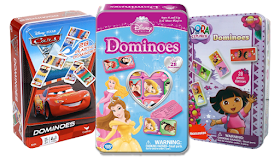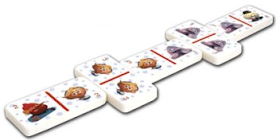 |
| Picture Dominoes - No counting or adding required |
Dominoes is a classic matching game that typically uses rectangle-shaped plastic or wood tiles that are lined up end-to-end during play. The original game of dominoes includes pieces with two sets of dots (pips), one on each end with a line down the middle, and requires mental math, strategy, and decision making to win. Picture dominoes do not come with numbers and therefore is a much more straight-forward game of matching.
There are six different characters featured in each game and they usually come in a tin box. Some of the tiles have two of the same characters (a double), and most have two different characters pictured. This kid-version of dominoes comes in many different character themes, typically based on Disney characters, movies or cartoons.
Object:
Be the first person to play all your dominoes.
Set up:
Place all the dominoes face-down on the table and mix them. Each player chooses seven dominoes and stands them up in front of himself so that only he can see what he has. The rest of the dominoes are left in the face-down position and create the draw pile. Push these to the side.
Play:
One player places a double in the middle of the players in a vertical position and the game begins. On each turn, a player is allowed to place one domino. This domino must have a picture that matches a picture on the end of a domino already in play. If the domino is a double, it is placed vertically, and if it is not, the domino is placed horizontally. You can play off all four sides of the initial domino. Some people play that you can also play off all four sides of any double that is played. As the game progresses, a long line of tiles is created.
If the player does not have a match, he is required to pick from the draw pile. Some people play that you have to pick until you get a match or until all the tiles are gone. Other people play that you pick only one tile. If you pick a tile you can use, play it. If not, you must keep the tile(s) and your turn is over. Play until one player plays all his tiles and wins the game.
Try this:
- Work on matching by lining them up as far as you can.
- Prop them up on their sides, sort and stack them by picture, or stand them up side by side and push the first one to knock them over.
- Place a long line of dominoes on the table and make an error with one to two of them. Ask the individual to trace the line with his eyes and find the error(s).
- Place all the tiles face up on the table. Give the individual a double, say Dora. Ask him to find all the tiles that have Dora on them. Turn some of the tiles upside down or sideways for a more difficult task. Start with fewer tiles to choose from for an easier task.
- Place all the tiles face up on the table. Give verbal instructions to find tiles, such as a tile with Snow White and Cinderella. Then find a tile with Ariel and Belle, etc.
- Turn a piece in-hand to the correct orientation before placing it in line (instead of spinning it on the table top).
- Make a long line of dominoes. Place matching pieces in the players hand, one at a time, and ask him to turn it in-hand and place on the correct end.
- Work on visual discrimination, spatial relations, figure ground, visual form constancy, in-hand manipulation, manual dexterity, executive functioning skills, process skills, socialization skills, play and leisure exploration and participation
If you are interested in purchasing this game or just want more information, click on the image below.



No comments:
Post a Comment
Thank you for taking the time to comment.